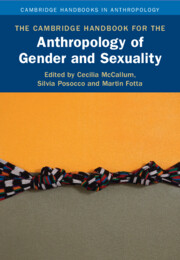Book contents
- The Cambridge Handbook for the Anthropology of Gender and Sexuality
- Cambridge Handbooks in Anthropology
- The Cambridge Handbook for the Anthropology of Gender and Sexuality
- Copyright page
- Contents
- Contributors
- 1 Introduction to The Cambridge Handbook for the Anthropology of Gender and Sexuality
- Part One Openings and Orientations
- Part Two Knowledges and Domains
- Part Three Resistances and Intersections
- Part Four Desires and Relations
- 18 Subjectivities, Knowledge, and Gendered and Sexual Transitions
- 19 Feminist and Queer Theories of the Non/Human and Paradoxical Possibilities of the Slash
- 20 Blood, Gender, and Politics in Indigenous View
- 21 “At Home” in Botox, Feminism, and Ethics
- Part Five Recursivities and Futures
- Name Index
- Subject Index
- References
19 - Feminist and Queer Theories of the Non/Human and Paradoxical Possibilities of the Slash
from Part Four - Desires and Relations
Published online by Cambridge University Press: 29 September 2023
- The Cambridge Handbook for the Anthropology of Gender and Sexuality
- Cambridge Handbooks in Anthropology
- The Cambridge Handbook for the Anthropology of Gender and Sexuality
- Copyright page
- Contents
- Contributors
- 1 Introduction to The Cambridge Handbook for the Anthropology of Gender and Sexuality
- Part One Openings and Orientations
- Part Two Knowledges and Domains
- Part Three Resistances and Intersections
- Part Four Desires and Relations
- 18 Subjectivities, Knowledge, and Gendered and Sexual Transitions
- 19 Feminist and Queer Theories of the Non/Human and Paradoxical Possibilities of the Slash
- 20 Blood, Gender, and Politics in Indigenous View
- 21 “At Home” in Botox, Feminism, and Ethics
- Part Five Recursivities and Futures
- Name Index
- Subject Index
- References
Summary
The fields of critical animal studies and feminist new materialisms have important implications for anthropology. In attending to ethics in human-animal relations, these fields not only decenter but also destabilize the very category of the Human. In conversation with critical animal studies and feminist anthropology, multispecies ethnography thinks with nonhumans and honors their specificities as both individuals and species. Multispecies ethnography encourages analysis of humans’ entanglement with other species as well as thinking about seemingly inanimate matter such as rocks as animate entities. Recognizing the animacy of objects offers interesting and important insights for ethnography. In this chapter, the author provides an overview of the cross-pollination of the multispecies and new materialist turns to explore how feminist and queer studies of the non/human are important for anthropology. Multispecies and feminist new materialist interrogations of sexuality are discussed, focusing on their innovative and important ethical contributions to human understandings of sexuality. The author argues that anthropology is uniquely positioned to intervene further in this conversation and posits that queering multispecies ethnography, rather than simply using nonhuman animals to reify or resist human formations of sexuality, can offer an opening to interrogate sexuality as a multispecies entanglement.
Keywords
- Type
- Chapter
- Information
- Publisher: Cambridge University PressPrint publication year: 2023



